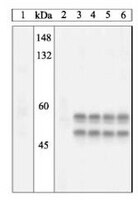PS1019 Sigma-AldrichPhosphoDetect™ Anti-JNK1/2 (pThr¹⁸³/Tyr¹⁸⁵) Rabbit pAb
This PhosphoDetect™ Anti-JNK1/2 (pThr¹⁸³/Tyr¹⁸⁵) Rabbit pAb is validated for use in Immunoblotting for the detection of JNK1/2 (pThr¹⁸³/Tyr¹⁸⁵).
More>> This PhosphoDetect™ Anti-JNK1/2 (pThr¹⁸³/Tyr¹⁸⁵) Rabbit pAb is validated for use in Immunoblotting for the detection of JNK1/2 (pThr¹⁸³/Tyr¹⁸⁵). Less<<Synonymes: Anti-c-Jun N-terminal Kinase 1&2, Phospho-Specific (Thr/Tyr183/185)
Produits recommandés
Aperçu
| Replacement Information |
|---|
Tableau de caractéristiques principal
| Species Reactivity | Host | Antibody Type |
|---|---|---|
| H, M, R | Rb | Polyclonal Antibody |
Prix & Disponibilité
| Référence | Disponibilité | Conditionnement | Qté | Prix | Quantité | |
|---|---|---|---|---|---|---|
| PS1019-100UL |
|
Ampoule plast. | 100 ul |
|
— |
| Product Information | |
|---|---|
| Form | Liquid |
| Formulation | In Dulbecco's PBS (without Mg2+ and Ca2+), 1 mg/ml BSA, 50% glycerol, pH 7.2-7.4. |
| Positive control | UV-treated HEK293 cells or sorbitol-treated PC12 cells |
| Preservative | ≤0.1% sodium azide |
| Quality Level | MQ100 |
| Physicochemical Information |
|---|
| Dimensions |
|---|
| Materials Information |
|---|
| Toxicological Information |
|---|
| Safety Information according to GHS |
|---|
| Safety Information |
|---|
| Product Usage Statements |
|---|
| Packaging Information |
|---|
| Transport Information |
|---|
| Supplemental Information |
|---|
| Specifications |
|---|
| Global Trade Item Number | |
|---|---|
| Référence | GTIN |
| PS1019-100UL | 04055977227109 |
Documentation
PhosphoDetect™ Anti-JNK1/2 (pThr¹⁸³/Tyr¹⁸⁵) Rabbit pAb FDS
| Titre |
|---|
PhosphoDetect™ Anti-JNK1/2 (pThr¹⁸³/Tyr¹⁸⁵) Rabbit pAb Certificats d'analyse
| Titre | Numéro de lot |
|---|---|
| PS1019 |
Références bibliographiques
| Aperçu de la référence bibliographique |
|---|
| Choudhury, B.K., et al. 2002. J. Immunol. 169, 5955. Barr, R.K., et al. 2001. Int. J. Biochem. Cell. Biol. 33, 1047. Dong, C., et al. 2001. J. Clin. Immunol. 21, 253. Janulis, M., et al. 2001. Mol. Cell. Biol. 21, 2235. Pearce, A.K., et al. 2001. Trends Cell Biol. 11, 426. Tong, T., et al. 2001. Exp. Cell Res. 269, 64. Cobb, M.H., et al. 1999. Prog. Biophys. Mol. Biol. 71, 479. Basu, S., et al. 1998. Oncogene 17, 3277. |








